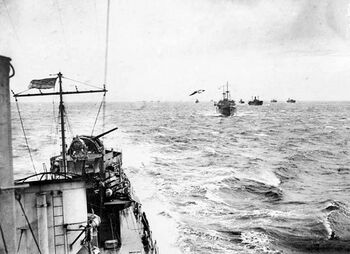Sundering Sea Campaign
| Sundering Sea Campaign | |||||||
|---|---|---|---|---|---|---|---|
| Part of the Siduri War | |||||||
 A convoy in the Sundering Sea | |||||||
| |||||||
| Belligerents | |||||||
|
Common Axis
|
Inner Sphere
| ||||||
| Commanders and leaders | |||||||
|
| |||||||
| Units involved | |||||||
| Sundering Fleet | |||||||
| Strength | |||||||
|
300-450 warships (peak) 2,000-3,000 aircraft |
200-350 warships (peak) 3,500-5,000 aircraft | ||||||
| Casualties and losses | |||||||
|
~23,000 sailors killed or missing 15,650 merchant seamen killed 1,866 merchant vessels sunk 86 warships lost 558 aircraft destroyed |
~34,000 sailors killed or missing 153 warships lost 859 aircraft destroyed | ||||||
The Sundering Sea Campaign was an extended naval campaign fought between the Common Axis and the Inner Sphere during the Siduri War from October 1934 to January 1938. Named after the Sundering Sea, which splits the continents of Siduri and Eracura and a vital trade route, the fighting occasionally spilled out into the Nuadan Ocean in the west and Bara Sea in the east. The core of the fighting took place over attempts to inhibit convoys and trade from neutral states to the belligerent powers, with both sides attempting to gain the upper hand by raiding the other side's convoys while protecting their own.
The Sundering Sea was a major strategic asset to both sides, while the Inner Sphere held the advantage of holding significant coastline through Syara and Shirvaniya, the Common Axis dominated the eastern mouth of the Sea and held territory on the south and western edges of Siduri, allowing for partial circumnavigation of the continent. Much of the conflict revolved around Common Axis efforts to secure trade from western Eracura to east Siduri while the Inner Sphere attempted to protect convoys from east Eracura to west Siduri. Both sides employed extensive usage of commerce raiders both lone ships and groups to further disrupt trade the flow of supplies to the other side. While heavy capital ships often play a major role in operations for both sides, the majority of engagements occurred between lighter vessels, especially corvettes and destroyers, and frequent usage of submarines and aircraft. Aircraft carriers saw their combat introduction in the campaign when the Cacertian Royal Navy employed them in early 1935, though they played only a minor role overall.
For most of the conflict the campaign was a stalemate with neither side able to break the other's control over their side of the Sundering Sea. While the Cacertian Admiralty weighed the possibility of a blockade of Syara, the effort proved too ambitious and was never realized. The Inner Sphere attempted to break the deadlock (and turn the tide of the war at sea) by capturing the Cacertian territory of Andria, but was defeated at the Battle of the Sabri Sea. Activity in the Sundering Sea sharply fell off after 1937 with the outbreak of the Eracuran War, which cut down most trade between the two continents. The removal of the Shirvani Dominionfrom the Inner Sphere further limited operations in the Sea, although scattered efforts continued until January 1938.